- As usual, I post a pdf file of the notes that I wrote today. Inspired by your questions we discussed various aspects of Problem 3 on Assignment 3.
- As usual, I post a pdf file of the notes that I wrote today.
- Today we talked about how series are used to prove Euler's identity: For all $\theta \in \mathbb{R}$ we have \[ e^{i \theta} = (\cos \theta) + i (\sin \theta). \] Here $i$ is the imaginary unit for which $i^2 = -1$. To prove Euler's identity we used the series representations (that is their Maclaurin series) of the exponential function, the cosine function and the sine function: \begin{alignat*}{2} e^x &= 1 + x + \frac{x^2}{2} + \frac{x^3}{3!} + \cdots + \frac{x^n}{n!} + \cdots &=& \sum_{k=0}^{\infty} \frac{x^k}{k!} \\ \cos x &= 1 - \frac{x^2}{2} + \frac{x^4}{4!} - \cdots + (-1)^n\frac{x^{2n}}{(2n)!} + \cdots &=& \sum_{k=0}^{\infty}(-1)^k \frac{x^{2k}}{(2k)!} \\ \sin x &= x - \frac{x^3}{3!} + \frac{x^5}{5!} - \cdots + (-1)^{n+1} \frac{x^{2n-1}}{(2n-1)!} + \cdots &=& \sum_{k=1}^{\infty} (-1)^{k+1} \frac{x^{2k-1}}{(2k-1)!} \end{alignat*}
-
To get a geometric sense of how the partial sums of the Maclaurin series of the exponential function converge to the exponential function in the animation below I present the first sixteen partial sums. They are polynomials up to degree 15:
\begin{align*}
\text{$0$-th degree polynomial is} & \quad 1 \\
\text{$1$-st degree polynomial is} & \quad 1 + x \\
\text{$2$-nd degree polynomial is} &\quad 1 + x + \frac{x^2}{2} \\
\text{$3$-rd degree polynomial is} &\quad 1 + x + \frac{x^2}{2} + \frac{x^3}{3!} \\
\text{$4$-th degree polynomial is} &\quad 1 + x + \frac{x^2}{2} + \frac{x^3}{3!} + \frac{x^4}{4!}\\
\text{$5$-th degree polynomial is} &\quad 1 + x + \frac{x^2}{2} + \frac{x^3}{3!} + \frac{x^4}{4!} + \frac{x^5}{5!} \\
\text{$6$-th degree polynomial is} &\quad 1 + x + \frac{x^2}{2} + \frac{x^3}{3!} + \frac{x^4}{4!} + \frac{x^5}{5!}+ \frac{x^6}{6!}
\end{align*}
In Mathematica I continued up to the degree $15$.
Place the cursor over the image to start the animation.
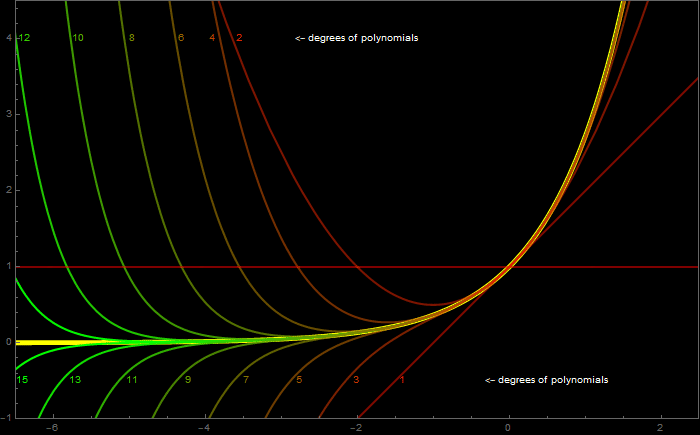
-
To get a geometric sense of how the partial sums of the Maclaurin series of the cosine function converge to the cosine function in the animation below I present the first fifteen partial sums. They are polynomials of even degrees up to degree 28:
\begin{align*}
\text{$0$-th degree polynomial is} & \quad 1 \\
\text{$2$-nd degree polynomial is} & \quad 1 - \frac{x^2}{2} \\
\text{$4$-th degree polynomial is} &\quad 1 - \frac{x^2}{2} + \frac{x^4}{4!} \\
\text{$6$-th degree polynomial is} &\quad 1 - \frac{x^2}{2} + \frac{x^4}{4!} - \frac{x^6}{6!} \\
\text{$8$-th degree polynomial is} &\quad 1 - \frac{x^2}{2} + \frac{x^4}{4!} - \frac{x^6}{6!} + \frac{x^8}{8!}\\
\text{$10$-th degree polynomial is} &\quad 1 - \frac{x^2}{2} + \frac{x^4}{4!} - \frac{x^6}{6!} + \frac{x^8}{8!} - \frac{x^{10}}{10!}
\end{align*}
In Mathematica I continued up to the degree $28$.
Place the cursor over the image to start the animation.
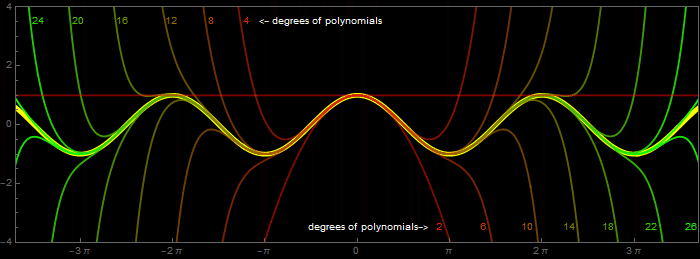
-
To get a geometric sense of how the partial sums of the Maclaurin series of the sine function converge to the sine function in the animation below I present the first fourteen partial sums. They are polynomials of odd degrees up to degree 27:
\begin{align*}
\text{$1$-st degree polynomial is} & \quad x \\
\text{$3$-rd degree polynomial is} & \quad x - \frac{x^3}{3!} \\
\text{$5$-th degree polynomial is} &\quad x - \frac{x^3}{3!} + \frac{x^5}{5!} \\
\text{$7$-th degree polynomial is} &\quad x - \frac{x^3}{3!} + \frac{x^5}{5!} - \frac{x^7}{7!} \\
\text{$9$-th degree polynomial is} &\quad x - \frac{x^3}{3!} + \frac{x^5}{5!} - \frac{x^7}{7!} + \frac{x^9}{9!}\\
\text{$11$-th degree polynomial is} &\quad x - \frac{x^3}{3!} + \frac{x^5}{5!} - \frac{x^7}{7!} + \frac{x^9}{9!} - \frac{x^{11}}{11!}
\end{align*}
In Mathematica I continued up to the degree $27$.
Place the cursor over the image to start the animation.
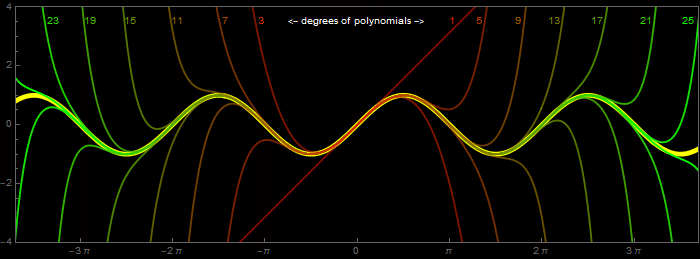
- As usual, I post a pdf file of the notes that I wrote today.
- In Problem 6 on Assignment 3 I ask you to study a rational in hexadecimal number system, interpret it as an infinite series and find the sum of that infinite series to determine a fraction in decimal number system which represents the same number. This is an excellent opportunity to learn about hexadecimal number system and how to do basic counting in that system. Recall that there are 16 digits in the hexadecimal system, see the Wikipedia page. The digits are 0, 1, 2, 3, 4, 5, 6, 7, 8, 9, A, B, C, D, E, F; the digit A stands for decimal 10, B stands for decimal 11, C stands for decimal 12, D stands for decimal 13, E stands for decimal 14, and F stands for decimal 15. So the number 100 in decimal system, in hexadecimal system is 64. since 100 = 6*16 + 4 (this identity in decimal system enables us to read the hexadecimal digits).
-
I hope that the table below is helpful to orient oneself among two-digit integers in hexadecimal system. There are 256 two-digits integers in hexadecimal system. They are (in hexadecimal system) 0, 1, 2,..., FE, FF. In the table below the yellow integers on black background are in the decimal system. The black numbers are two-digit integers in the hexadecimal system. The top row of the yellow integers on black background in decimal system represent the integers in the row below which are in the hexadecimal system.
The left-most column of the yellow integers on black background in decimal system represent the black integers next to them which are in hexadecimal system. The right-most column of the yellow integers on black background in decimal system represent the black integers next to them in which are in hexadecimal system. The bottom row of the yellow integers on black background in decimal system represent the black integers in the row above which are in the hexadecimal system.
0 1 2 3 4 5 6 7 8 9 10 11 12 13 14 15 0 0 1 2 3 4 5 6 7 8 9 A B C D E F 15 16 10 11 12 13 14 15 16 17 18 19 1A 1B 1C 1D 1E 1F 31 32 20 21 22 23 24 25 26 27 28 29 2A 2B 2C 2D 2E 2F 47 48 30 31 32 33 34 35 36 37 38 39 3A 3B 3C 3D 3E 3F 63 64 40 41 42 43 44 45 46 47 48 49 4A 4B 4C 4D 4E 4F 79 80 50 51 52 53 54 55 56 57 58 59 5A 5B 5C 5D 5E 5F 95 96 60 61 62 63 64 65 66 67 68 69 6A 6B 6C 6D 6E 6F 111 112 70 71 72 73 74 75 76 77 78 79 7A 7B 7C 7D 7E 7F 127 128 80 81 82 83 84 85 86 87 88 89 8A 8B 8C 8D 8E 8F 143 144 90 91 92 93 94 95 96 97 98 99 9A 9B 9C 9D 9E 9F 159 160 A0 A1 A2 A3 A4 A5 A6 A7 A8 A9 AA AB AC AD AE AF 175 176 B0 B1 B2 B3 B4 B5 B6 B7 B8 B9 BA BB BC BD BE BF 191 192 C0 C1 C2 C3 C4 C5 C6 C7 C8 C9 CA CB CC CD CE CF 207 208 D0 D1 D2 D3 D4 D5 D6 D7 D8 D9 DA DB DC DD DE DF 223 224 E0 E1 E2 E3 E4 E5 E6 E7 E8 E9 EA EB EC ED EE EF 239 240 F0 F1 F2 F3 F4 F5 F6 F7 F8 F9 FA FB FC FD FE FF 255 240 241 242 243 244 245 246 247 248 249 250 251 252 253 254 255
- As usual, I post a pdf file of the notes that I wrote today.
- Here is a pdf file of Limits and Infinite Series class notes; the relevant part is Subsection 3.3.6. The timestamp of these notes is 2020-11-30-20:49. When I update the notes this timestamp will change to a later date and time.
- As usual, I post a pdf file of the notes that I wrote today.
- Here is a pdf file of Limits and Infinite Series class notes; the relevant parts are in Subsection 3.3.5 and the beginning of Subsection 3.3.6. The timestamp of these notes is 2020-11-24-18:43. When I update the notes this timestamp will change to a later date and time.
- As usual, I post a pdf file of the notes that I wrote today.
- Here is a pdf file of Limits and Infinite Series class notes; the relevant parts are in Subsection 3.3.4 and the beginning of Subsection 3.3.5. The timestamp of these notes is 2020-11-23-16:59. When I update the notes this timestamp will change to a later date and time.
- Today I posted Assignment 3. In Problem 1 I use a version of the round to the nearest integer function given by the following formula \[ \lceil x \rfloor = \lfloor x + 1/2 \rfloor = \left\lceil \frac{\lfloor 2 x \rfloor}{2} \right\rceil, \qquad x \in \mathbb{R}. \] Or, explicitly, \[ \forall x \in \mathbb{R} \ \forall m \in \mathbb{Z} \quad m = \lceil x \rfloor \quad \Leftrightarrow \quad m - \frac{1}{2} \leq x < m + \frac{1}{2}. \] Below is a graph of this round function. In Problem 1 I ask you to prove that the function \[ g(x) = \frac{1}{2} \bigl( 2 x - \lceil x \rfloor \bigr) \lceil x \rfloor, \qquad x \in \mathbb{R}, \] is continuous on $\mathbb{R}.$ In this task it can help you to draw a detailed graph of this function on the grid that I provide below.
The round function used in Problem 1 on Assignment 3
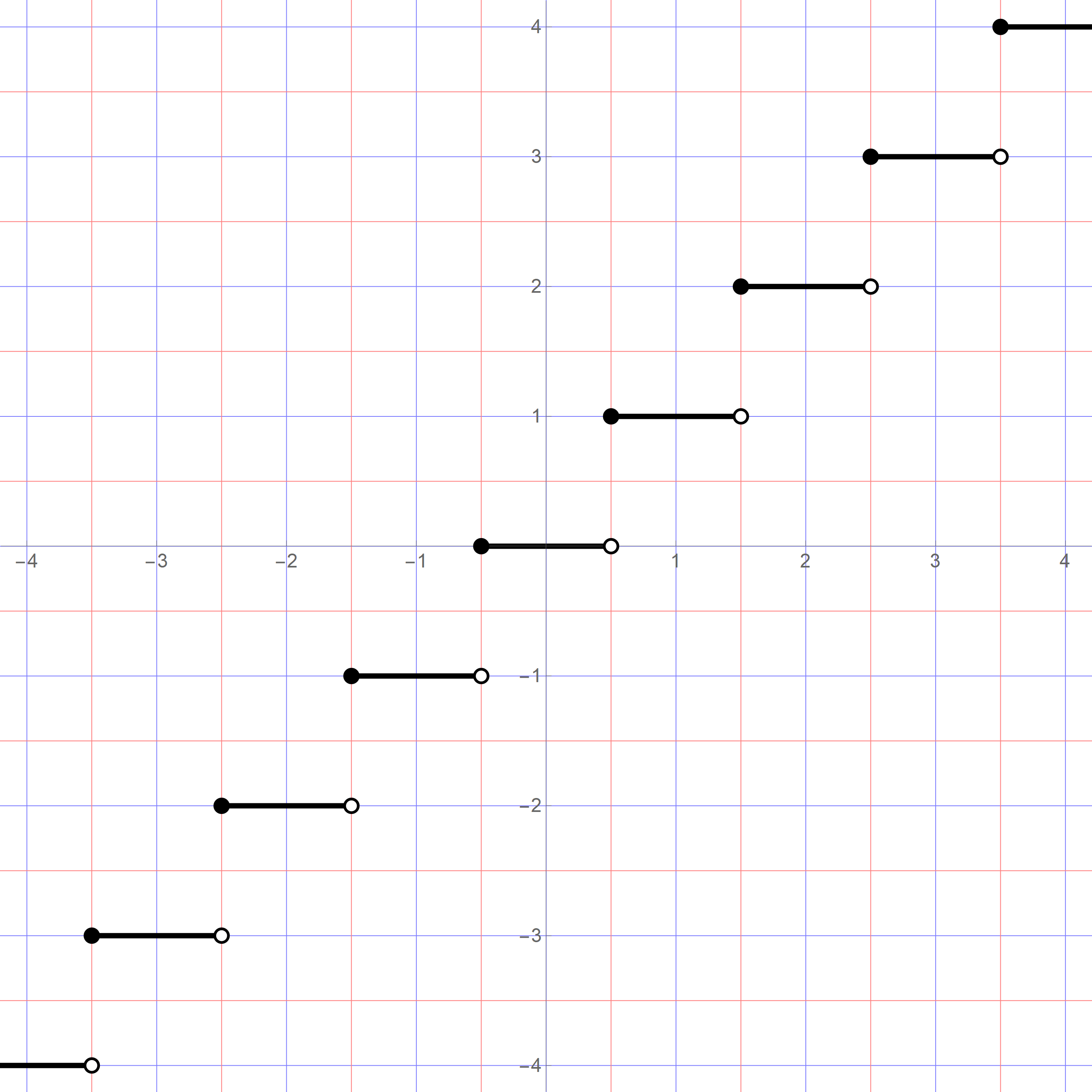
Click here for a pdf file with this grid.
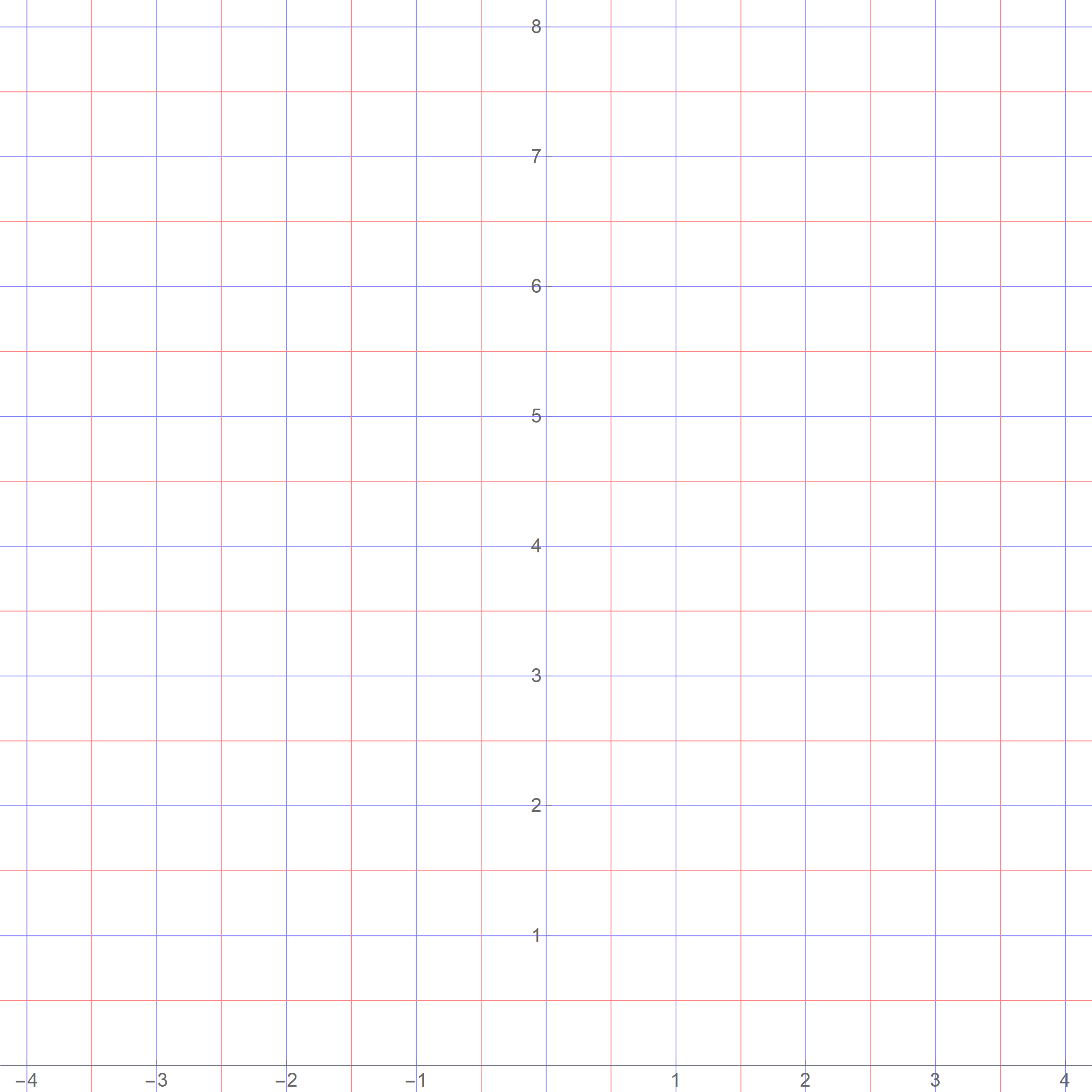
- As usual, I post a pdf file of the notes that I wrote today.
- As usual, I post a pdf file of the notes that I wrote today.
- Here is a pdf file of Limits and Infinite Series class notes; the relevant parts are in Section 3.2 and the beginning of Section 3.3. The timestamp of these notes is 2020-11-19-17:52. When I update the notes this timestamp will change to a later date and time.
- I promised a proof of \[ \sum_{n=1}^{\infty} \frac{1}{n^2} = \frac{\pi^2}{6} \] from first principles (as much as possible). The problem of proving the preceding equality is called the Basel problem. I was hoping for a shorter proof. But, on the other hand, there are many short proofs on the internet that use "well-known" facts and cite big theorems from different branches of Mathematics. I wanted a proof that will collect everything that is needed in one document. I hope that I have achieved that. Here is my proof. Please let me know of any errors. Also let me know if you do not understand a part of the proof. I want to improve it.
- As usual, I post a pdf file of the notes that I wrote today. We finished Section 3.2. Do Exercises 3.34, 3.35.
- As usual, I post a pdf file of the notes that I wrote today.
- Here is a pdf file of Limits and Infinite Series class notes; the relevant part is in Section 3.2 in particular Subsections 3.2.2, 3.2.3, and 3.2.4. The timestamp of these notes is 2020-11-16-21:36. When I update the notes this timestamp will change to a later date and time.
- As usual, I post a pdf file of the notes that I wrote today.
- As usual, I post a pdf file of the notes that I wrote today. We proved two consequences of the Monotone Convergence Theorem: \[ \exists\mkern+1.5mu \alpha \in \mathbb{R}_+ \quad \text{such that} \quad \alpha^2 = 2. \] \[ \forall\mkern+0.5mu p \in \mathbb{Z} \ \ \forall\mkern+0.5mu q \in \mathbb{N} \qquad e \neq \frac{p}{q}. \]
- In class I presented a proof that $e$ is irrational. This proof is my variation on the proof given by Joseph Fourier who gave name to Fourier series. The linked file contains the annotations that I added during the class. I also post an annotated version of this note with the annotations that I made in class.
-
On November 2 I posted a table of thirteen sequences. In class we proved that Seq. D converges. It's limit is $e.$ In the preceding item we used this fact to prove that $e$ is irrational. Another important sequence which converges to $e$ is Seq. E from November 2. I wrote a short paper in which I prove that both sequences Seq. D and Seq. E converge and that they converge to the same limit. The only tools that I use in this proof are the Squeeze Theorem for sequences and the Binomial Theorem.
- A squeeze for two common sequences that converge to $e$. The College Mathematics Journal 45 (2014) no. 5, 391-392. doi:10.4169/college.math.j.45.5.391. (local pdf)
- Comment. You will notice that in this paper I cite a website with a beautiful story of Carl Friedrich Gauss's boyhood discovery of the "trick" for summing an arithmetic progression: \[ 1+ 2 + \cdots + n = \frac{n(n+1)}{2}. \] I found the above linked article on this website; it is not there anymore. However, the auther Brian Hayes created a website on which he hosts all his creations. Enjoy it.
- In class Seq. B from November 2 was defined as \[ x_1 = 2, \qquad x_{n+1} = \frac{x_n}{2} + \frac{1}{x_n} \quad \text{for all} \quad n\in \mathbb{N} . \] In class (and in the class notes) we proved that the above sequence has the following properties \begin{equation}\tag{B1} \label{eq:B1} \forall\mkern+0.5mu n \in \mathbb{N} \qquad x_n \gt 0 \ \land \ (x_n)^2 \geq 2. \end{equation} Then we noticed that \begin{equation}\tag{B2} \label{eq:B2} \forall\mkern+0.5mu a \in \mathbb{R} \qquad a \gt 0 \ \land \ a^2 \geq 2 \quad \Rightarrow \quad a\geq 1 \end{equation} and (here $\mathbb{R}_+$ denotes the set of all positive real numbers) \begin{equation}\tag{B3} \label{eq:B3} \forall\mkern+0.5mu a \in \mathbb{R}_+ \qquad a^2 \geq 2 \ \Leftrightarrow \ \frac{a}{2} + \frac{1}{a} \leq a. \end{equation} From $\eqref{eq:B1}$, $\eqref{eq:B2}$ and $\eqref{eq:B3}$ that \[ \forall\mkern+0.5mu n \in \mathbb{N} \qquad x_n \gt 1 \ \land \ x_{n+1} \leq x_n. \] That is, the sequence $\{x_n\}$ is bounded below and nonincreasing. By the Monotone Convergence Theorem it converges. Set \[ L = \lim_{n\to\infty} x_n. \] Since for all $n \in \mathbb{N}$ we have $x_n \gt 1$ and $1 = \lim_{n\to\infty} 1,$ by the theorem proved on November 5 we have \[ L \geq 1. \] It should not be too difficult to prove \[ \lim_{n\to\infty} x_{n+1} = L \] and by the Algebra of Convergent Sequences \[ \lim_{n\to\infty} \left( \frac{x_n}{2} + \frac{1}{x_n} \right) = \frac{L}{2} + \frac{1}{L}. \] The last two limits and the equality \[ \forall\mkern+0.5mu n \in \mathbb{N} \ \ x_{n+1} = \frac{x_n}{2} + \frac{1}{x_n}, \] imply \[ L = \frac{L}{2} + \frac{1}{L}. \] Hence $L^2 = 2$ and $L\geq 1.$ This proves that $L$ is a positive real number whose square is $2.$ That is the well known number $\sqrt{2}.$ However, you might have overlooked that the fact that there exists a unique positive real number whose square is $2$ has never been rigorously proven in your previous math classes. We are proud that we proved it rigorously in this class as an application of the Monotone Convergence Theorem. It is important to emphasize that the existence of $\sqrt{2}$ cannot be proved without the Completeness Axiom.
-
Seq. B can be adopted to prove the existence of the square root of any real number $a \in (1,+\infty)$. For this we need to consider the sequence
\[
x_1 = a, \qquad x_{n+1} = \frac{x_n}{2} + \frac{a}{2 x_n} \quad \text{for all} \quad n \in \mathbb{N}.
\]
To use the Monotone Convergence Theorem we need to prove the following facts:
- $\displaystyle \forall\mkern+0.5mu n \in \mathbb{N} \quad x_n \gt 0.$
- $\displaystyle \forall\mkern+0.5mu n \in \mathbb{N} \quad \bigl(x_n\bigr)^2 \geq a.$
- $\displaystyle \forall\mkern+0.5mu n \in \mathbb{N} \quad x_n \geq 1.$
- $\displaystyle \forall\mkern+0.5mu n \in \mathbb{N} \quad x_n \geq x_{n+1}.$
- As usual, I post a pdf file of the notes that I wrote today.
- Here is a pdf file of Limits and Infinite Series class notes; the relevant part is Subsection 3.1.4. The timestamp of these notes is 2020-11-10-17:35. When I update the notes this timestamp will change to a later date and time.
- Today we proved that the sequence \[ S_n = \sum_{k=1}^n \frac{1}{k!}, \quad n \in \mathbb{N}, \] converges. Its limit is the famous real number $e.$ You have probably heard the claim that $e$ is irrational. Are you curious to see a proof of this claim? What needs to be proved is the following \[ \forall\mkern+0.5mu p \in \mathbb{Z} \ \ \forall\mkern+0.5mu q \in \mathbb{N} \qquad e \neq \frac{p}{q}. \] This is exactly what is proved in the note that I post. The proof in this note is my variation on the proof given by the famous French mathematician Joseph Fourier. I hope that you can understand this proof. Questions about it are welcome.
- Today we celebrated the great Monotone Convergence Theorem. As usual, I post a pdf file of the notes that I wrote today.
- Here is a pdf file of Limits and Infinite Series class notes; the relevant part is Subsection 3.1.4. The timestamp of these notes is 2020-11-09-17:33. When I update the notes this timestamp will change to a later date and time.
- Here I will answer Joe's question asked in class today. Recall the Axioms of the Real Numbers or see this annotated version. Denote by MCT the following statement: "Every bounded monotonic sequence converges" and denote by CA the Completeness Axiom. Then we can rephrase the Monotone Convergence Theorem as follows: Assume that Axioms 1-15 hold. Then CA implies MCT. The converse of the preceding implication also holds. That is, the following claim is true: Assume that Axioms 1-15 hold. Then CA if and only if MCT. We only need to prove the converse of the Monotone Convergence Theorem. That is, we need to prove: Assume that Axioms 1-15 hold. Then MCT implies CA.
-
I remember writing a proof of the statement: Assume that Axioms 1-15 hold. Then MCT implies CA down some time ago, but I could not find it on my computer. Probably I never converted my handwritten notes to LaTeX. I should write a LaTeX document and post it! That will not get lost. Also, I should recall what I wrote earlier to celebrate writing.
I came, I thought, I wrote, I taught, I thought more, I rewrote.
Verba volant, scripta manent.
(Spoken words fly away, written words stay.)
- Today we talked about the preliminaries for the Monotone Convergence Theorem. As usual, I post a pdf file of the notes that I wrote today. Here is a pdf file of Limits and Infinite Series class notes; the relevant part is Subsection 3.1.4. The timestamp of these notes is 2020-11-05-18:03. When I update the notes this timestamp will change to a later date and time.
-
Today I proved in detail the following theorem:
Theorem. Let $a:\mathbb{N} \to \mathbb{R}$ and $b:\mathbb{N} \to \mathbb{R}$ be two sequences. Assume:
- $a:\mathbb{N} \to \mathbb{R}$ is a convergent sequence and $\displaystyle \lim_{n\to+\infty} a_n = K$.
- $b:\mathbb{N} \to \mathbb{R}$ is a convergent sequence and $\displaystyle \lim_{n\to+\infty} b_n = L$.
- There exists $n_0 \in \mathbb{N}$ such that \[ \forall\mkern+0.5mu n\in \mathbb{N} \quad \text{we have} \quad n \geq n_0 \quad \Rightarrow \quad a_n \leq b_n \]
Proof. Let $\epsilon \gt 0$ be arbitrary.- By assumption A there exists $N_a(\epsilon) \in \mathbb{R}$ such that \[ \forall\mkern+0.5mu n \in \mathbb{N} \quad \text{we have} \quad n \gt N_a(\epsilon) \quad \Rightarrow \quad -\epsilon + K \lt a_n \lt K + \epsilon. \]
- By assumption B there exists $N_b(\epsilon) \in \mathbb{R}$ such that \[ \forall\mkern+0.5mu n \in \mathbb{N} \quad \text{we have} \quad n \gt N_b(\epsilon) \quad \Rightarrow \quad -\epsilon + L \lt b_n \lt L + \epsilon. \]
- This is assumption C: There exists $n_0 \in \mathbb{N}$ such that \[ \forall\mkern+0.5mu n\in \mathbb{N} \quad \text{we have} \quad n \geq n_0 \quad \Rightarrow \quad a_n \leq b_n \]
The last implication is true since its contrapositive is true: \[ K-L \gt 0 \quad \Rightarrow \quad \exists \epsilon \gt 0 \quad \text{such that} \quad K - L \geq 2\epsilon, \] and this contrapositive is true since we can simply choose $\epsilon = \frac{1}{2}(K-L) \gt 0.$ - I post a pdf file of the notes that I wrote today during the class. The relevant part of my Limits and Infinite Series class notes is Subsection 3.1.3. Here is a pdf file of Limits and Infinite Series class notes. The timestamp of these notes is 2020-11-05-18:03. When I update the notes, this timestamp will change to a later date and time.
- I hope that the animation below will help you get appropriate inequality in Problem 7 on Assignment 2. To understand the animation below and how it can help you solve Problem 7 you need to understand what I posted on October 30, 2020.
Place the cursor over the image to start the animation.
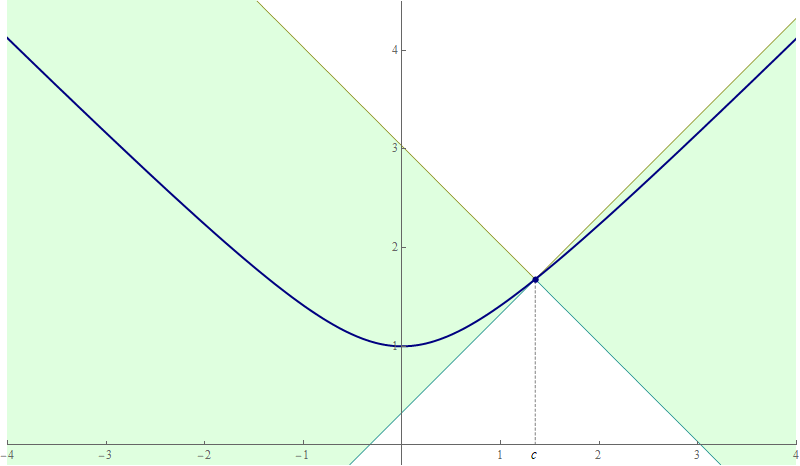
- I post a pdf file of the notes that I wrote today during the class. The relevant part of my Limits and Infinite Series class notes is Subsection 3.1.3. Here is a pdf file of Limits and Infinite Series class notes. The timestamp of these notes is 2020-11-03-11:18. When I update the notes, this timestamp will change to a later date and time.
- We started a story about sequences of real numbers today. A sequence of real numbers is a function whose domain is the set $\mathbb{N}$ of positive integers or the set $\mathbb{N}_0$ of nonnegative integers and whose codomain is the set of real numbers $\mathbb{R}.$
- I mention in class how computers love sequences. One example are spreadsheets. As an example, I created a Google Sheet with several sequences that we mentioned in class. I present 13 sequences in this spreadsheet. Please look at the formulas in Seq. G: I used an interesting Google Sheet function: =INDIRECT("G"&(A5-G4+2))+1.
| Sequence name |
Sequence formula | Comment |
|---|---|---|
| Seq. A | $a_n = n, \ n\in \mathbb{N}_0$ | This is the identity sequence; the value is equal to the index. bounded below, not bounded above, increasing |
| Seq. B | $b_1 = 2,\ \displaystyle b_{n+1} = \frac{b_n}{2} + \frac{1}{b_n}, \ n \in \mathbb{N}$ | recursively defined, decreasing, converges to $\sqrt{2}$ |
| Seq. C | $c_0 = 1,\ \displaystyle c_{n} = n \, c_{n-1}, \ n \in \mathbb{N}$ | recursively defined, increasing,
bounded below, not bounded above, the common notation is $c_n = n!$ $n!$ is called the factorial of a positive integer $n$ |
| Seq. D | $d_0 = 1,\ \displaystyle d_{n} = d_{n-1} + \frac{1}{n!}, \ n \in \mathbb{N}$ | recursively defined, increasing, converges to $e$ a sequence like this is called an infinite series |
| Seq. E | $\displaystyle e_{n} = \left(1 + \frac{1}{n}\right)^n, \ n \in \mathbb{N}$ | defined by a closed form expression of $n$, increasing, converges to $e$ |
| Seq. F | $\displaystyle f_{n} = \left\lfloor \frac{1}{2} + \sqrt{2 n} \right\rfloor, \ n \in \mathbb{N}$ | defined by a closed form expression of $n$, non-decreasing, bounded below, not-bounded above |
| Seq. G | $\displaystyle \begin{array}{l} g_1 = 1, \\ g_2 = 2, \end{array} \ g_{n} = g_{n-g_{n-1}} + 1 , \ n \in \{3,4,5, \ldots \}$ | recursively defined, non-decreasing, bonded below, not bounded above, see some interesting Google Sheet formulas here |
| Seq. H | $\displaystyle h_0 = 1, \ h_{n} = \frac{1}{2} \, h_{n-1} , \ n \in \mathbb{N}$ | recursively defined, decreasing, converges to $0,$ this is the sequence of powers of $1/2$ |
| Seq. I | $\displaystyle i_0 = 1, \ i_{n} = i_{n-1} + \left(\frac{1}{2}\right)^n , \ n \in \mathbb{N}$ | recursively defined, increasing, converges to $2$, this is a geometric (infinite) series |
| Seq. J | $\displaystyle j_0 = 1, \ j_{n} = \frac{5}{7} \, j_{n-1} , \ n \in \mathbb{N}$ | recursively defined, decreasing, converges to $0$ this is the sequence of powers of $5/7$ |
| Seq. K | $\displaystyle k_0 = 1, \ k_{n} = k_{n-1} + \left(\frac{5}{7}\right)^n , \ n \in \mathbb{N}$ | recursively defined, increasing, converges to $7/2$, this is a geometric (infinite) series |
Seq. L | $\displaystyle l_0 = 1, \ l_{n} = \left(-\frac{1}{2}\right) \, l_{n-1} , \ n \in \mathbb{N}$ | recursively defined, converges to $0$ this is the sequence of powers of $-1/2$ |
| Seq. M | $\displaystyle m_0 = 1, \ m_{n} = m_{n-1} + (-1)^n \left(\frac{1}{2}\right)^n , \ n \in \mathbb{N}$ | recursively defined, neither non-decreasing, nor non-increasing, converges to $2/3$, this is a geometric (infinite) series |
- The sequences Seq. D, Seq. I, Seq. K, Seq. M in the table above have the special form. In each of these cases we start with a sequence, say \[ t: \mathbb{N}_0 \to \mathbb{R} \quad \text{with the values} \quad t_0, t_1, t_2, t_3, \ldots \] Then we form another sequence $S: \mathbb{N}_0 \to \mathbb{R}$ using the following recursive formula: \[ S_0 = t_0, \quad S_n = S_{n-1} + t_n, \quad n \in \mathbb{N}. s \] The values of the sequence $S: \mathbb{N}_0 \to \mathbb{R}$ are \begin{align*} S_0 & = t_0 \\ S_1 & = t_0 + t_1 \\ S_2 & = t_0 + t_1 + t_2 \\ S_3 & = t_0 + t_1 + t_2 + t_3 \\ & \ \ \vdots \\ S_n &= t_0 + t_1 + \cdots + t_n = \sum_{k=0}^n t_k \\ & \ \ \vdots \\ \end{align*} The sequence $\{ S_n, n \in \mathbb{N}_0 \},$ is called the infinite series. This infinite series is is also denoted by $\displaystyle \sum_{k=0}^{\infty} t_k$. For $n \in \mathbb{N}_0$ the sum \[ S_n = t_0 + t_1 + \cdots + t_n = \sum_{k=0}^n t_k \] is called the $n$-th partial sum of the infinite series $\displaystyle \sum_{k=0}^{\infty} t_k$.
- As usual, I post a pdf file of the notes that I wrote today. The relevant part of my Limits and Infinite Series class notes are Subsections 3.1.1 and 3.1.2 in Chapter 3. Please understand Example 3.6.
-
The most important definition here is the definition of continuity of functions defined on intervals. Recall that there are four kinds of finite intervals; with $a, b \in \mathbb R$ and $a \lt b$, the finite intervals are:
\[
(a,b), \quad (a,b], \quad [a,b), \quad [a,b].
\]
There are four kinds of infinite intervals; with $a \in \mathbb R$, the infinite intervals are:
\[
(a,+\infty), \quad [a,+\infty), \quad (-\infty,a), \quad (-\infty,a];
\]
and also $\mathbb R$ is an infinite interval, sometimes written as $(-\infty,+\infty).$
- Here I will use the notation $\mathbb{R}_+$ for the set of all positive real numbers. Today in class we studied the function $f:\mathbb{R}_+ \to \mathbb{R}$ defined by \[ f(x) = \frac{1}{x}, \quad x \in \mathbb{R}_+. \] We proved the following inequality \[ \forall\mkern+0.5mu c\in \mathbb{R}_+ \quad \forall\mkern+0.5mu x \in \left(\frac{c}{2}, \frac{3c}{2} \right) \quad \text{we have} \quad \left| \frac{1}{x} - \frac{1}{c} \right| \leq \frac{2}{c^2} | x - c |. \] This inequality was essential to proving that the function $f$ is continuous on $\mathbb{R}_+.$ In fact, as a consequence of the preceding inequality we proved the following implication \[ \forall\mkern+0.5mu c \in \mathbb{R}_+ \quad \forall\mkern+0.5mu \epsilon \gt 0 \quad \forall\mkern+0.5mu x \in \mathbb{R}_+ \quad \text{we have} \quad |x-a| \lt \min\left\{ \epsilon \, \frac{c^2}{2}, \frac{c}{2} \right\} \quad \Rightarrow \quad \left| \frac{1}{x} - \frac{1}{c} \right| \lt \epsilon. \] I expect that you can prove the last implication. If not, please let me know where you encounter problems. The preceding implication proves that the function $f$ is continuous on $\mathbb{R}_+.$
- Our next goal was to prove that the trigonometric functions $\cos$ and $\sin$ are continuous on $\mathbb{R}.$ In fact, we will prove that these functions are uniformly continuous on $\mathbb{R}.$
- I will start by making two claims. The following inequality holds: \[ \forall\mkern+0.5mu x \in \mathbb{R} \quad \forall\mkern+0.5mu c \in \mathbb{R} \quad \text{we have} \quad \bigl| \cos(x) - \cos(c) \bigr| \leq | x - c |. \] The following inequality holds: \[ \forall\mkern+0.5mu x \in \mathbb{R} \quad \forall\mkern+0.5mu c \in \mathbb{R} \quad \text{we have} \quad \bigl| \sin(x) - \sin(c) \bigr| \leq | x - c |. \]
- Next, I will show how the above inequalities can be rewritten as a sandwich squeeze. In class, see Exercise 14, we proved that for all real numbers $u$ and $v$ and all nonnegative real numbers $w$ we have \[ |u - v| \leq w \quad \Leftrightarrow \quad v - w \leq u \leq v + w. \] Applying the preceding equivalence to $\bigl| \cos(x) - \cos(c) \bigr| \leq | x - c |$ we obtain \[ \forall\mkern+0.5mu x \in \mathbb{R} \quad \forall\mkern+0.5mu c \in \mathbb{R} \quad \text{we have} \quad \cos(c) - | x - c | \leq \cos(x) \leq \cos(c) + | x - c |. \] This is a sandwich squeeze. And it can be beautifully illustrated with an animation
Place the cursor over the image to start the animation.
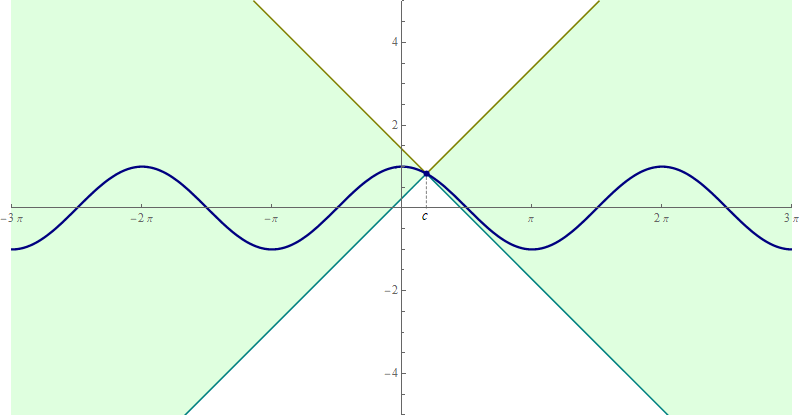
- Similarly, applying the equivalence from the preceding item to $\bigl| \sin(x) - \sin(c) \bigr| \leq | x - c |$ we obtain \[ \forall\mkern+0.5mu x \in \mathbb{R} \quad \forall\mkern+0.5mu c \in \mathbb{R} \quad \text{we have} \quad \sin(c) - | x - c | \leq \sin(x) \leq \sin(c) + | x - c |. \] Again, this is a sandwich squeeze. And it can be beautifully illustrated with an animation
Place the cursor over the image to start the animation.
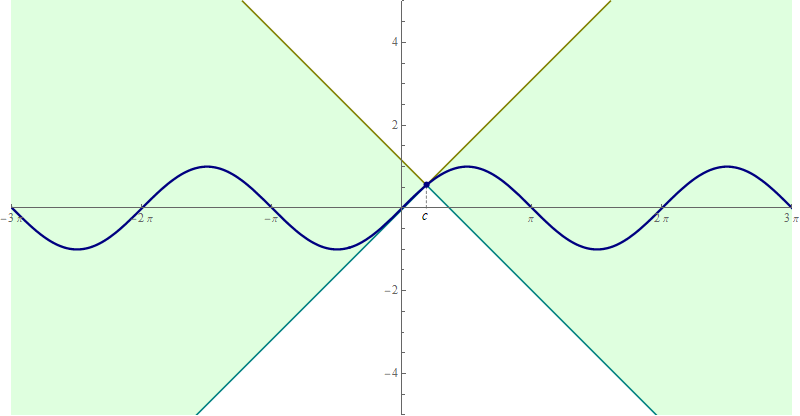
- The above animations are quite convincing that the stated inequalities are true. However, I hope that you have not lost your appetite for algebraic proofs.
- As usual, I post a pdf file of the notes that I wrote today. The relevant part of my Limits and Infinite Series class notes is Section 2.4. Notice that in the notes I also proved that the square root function is continuous on the interval $[0,+\infty).$
- Today we talked about one of the fundamental concepts of mathematics: the continuity. I am posting a pdf file of the notes I wrote today.
-
The most important definition here is the definition of continuity of functions defined on intervals. Recall that there are four kinds of finite intervals; with $a, b \in \mathbb R$ and $a \lt b$, the finite intervals are:
\[
(a,b), \quad (a,b], \quad [a,b), \quad [a,b].
\]
There are four kinds of infinite intervals; with $a \in \mathbb R$, the infinite intervals are:
\[
(a,+\infty), \quad [a,+\infty), \quad (-\infty,a), \quad (-\infty,a];
\]
and also $\mathbb R$ is an infinite interval, sometimes written as $(-\infty,+\infty).$
- Today I continued writing about the four famous trigonometric limits in the same pdf file during the class. We finished the proofs of four trigonometric limits from first principles \[ \lim_{x\to 0} \cos x = 1, \quad \lim_{x\to 0} \sin x = 0, \quad \lim_{x\to 0} \frac{\sin x}{x} = 1, \quad \lim_{x\to 0} \frac{1 - \cos x}{x^2} = \frac{1}{2}. \] It is interesting to point out that for each of these four functions we proved the same looking inequality \begin{gather*} \forall\mkern+0.5mu x \in (-1,1) \phantom{(0,1)} \qquad \bigl| \cos x - 1 \bigr| \leq |x| \\ \forall\mkern+0.5mu x \in (-1,1) \phantom{(0,1)} \qquad \bigl| \sin x - 0 \bigr| \leq |x| \\ \forall\mkern+0.5mu x \in (-1,0)\cup (0,1) \qquad \left| \frac{\sin x}{x} - 1 \right| \leq |x| \\ \forall\mkern+0.5mu x \in (-1,0)\cup (0,1) \qquad \left| \frac{1-\cos x}{x^2} - \frac{1}{2} \right| \leq |x| \end{gather*} And each of these inequalities is proved by using geometric reasoning involving objects related to the unit circle. That is what I would call reasoning from first principles. Geometric objects on the unit circle is where trigonometric functions come from.
- The relevant part from my Limits and Infinite Series class notes is Subsection 2.3.2. Here is a pdf file of Limits and Infinite Series class notes. The timestamp of these notes is 2020-10-26-21:21. When I update the notes, this timestamp will change to a later date and time.
- I post a pdf file of the notes that I wrote today during the class. Today we did the proofs of four trigonometric limits from first principles \[ \lim_{x\to 0} \cos x = 1, \quad \lim_{x\to 0} \sin x = 0, \quad \lim_{x\to 0} \frac{\sin x}{x} = 1, \quad \lim_{x\to 0} \frac{1 - \cos x}{x^2} = \frac{1}{2}. \] When I say that we do proofs from first principles, I mean using the definition of cosine and sine on the unit circle and geometric properties of lengths and areas. I am always suspicious of proofs that rely on too many layers of sophisticated background knowledge. Sometimes what is used in a proof is more sophisticated than what is being proved, leaning towards a proof by confusion style! After all, we are in service of clarity.
- The relevant part from my Limits and Infinite Series class notes is Subsection 2.3.2. Here is a pdf file of Limits and Infinite Series class notes. The timestamp of these notes is 2020-10-26-21:21. When I update the notes, this timestamp will change to a later date and time.
- I post a pdf file of the notes that I wrote today during the class. Today we did the Sandwich Squeeze Theorem and its proof.
- I post a pdf file of the notes that I wrote today during the class. Today we did two definitions of onesided limits: \[ \lim_{x\downarrow a} f(x) = L \quad \text{and} \quad \lim_{x\uparrow a} f(x) = L. \] where $a,L \in \mathbb{R}.$
-
Now that we did many different definition of limits, I feel that I need to tell you where is this topic continuing in more advanced mathematical analysis classes. Let us first review the main definition of the limit for a real function.
- (I) $\exists \delta_0 \gt 0$ such that $(a-\delta_0, a) \cup (a,a+\delta_0) \subseteq \mathbb{R}$.
- (II) $\forall\mkern 2mu \epsilon \gt 0 \quad \exists\mkern 2mu \delta(\epsilon)$ such that $0 \lt \delta(\epsilon) \leq \delta_0$ and \begin{equation*} 0 \lt |x-a| \lt \delta(\epsilon) \quad \Rightarrow \quad |f(x) - L| \lt \epsilon. \end{equation*}
-
So, the first step towards a more general definition of limit is to introduce an abstract concept of distance.
Definition. Let $\mathcal A$ be a nonempty set. A function $d_{\mathcal A}$ defined for all pairs of elements of $\mathcal A$ is called a distance on $\mathcal A$ if it satisfies the following four conditions:
- (a) $\forall\mkern+0.5mu x, y \in \mathcal A$ we have $d_{\mathcal A}(x,y) \geq 0.$
- (b) $\forall\mkern+0.5mu x, y \in \mathcal A$ we have $d_{\mathcal A}(x,y) = 0 \ \ \Leftrightarrow \ \ x = y.$
- (c) $\forall\mkern+0.5mu x, y \in \mathcal A$ we have $d_{\mathcal A}(x,y) = d_{\mathcal A}(y,x).$
- (d) $\forall\mkern+0.5mu x, y, z \in \mathcal A$ we have $d_{\mathcal A}(x,y) \leq d_{\mathcal A}(x,z) + d_{\mathcal A}(z,y).$ A nonempty set $\mathcal A$ together with a distance $d_{\mathcal A}$ defined on it is called a metric space. Such metric space is usually written as a pair $\bigl(\mathcal A, d_{\mathcal A}\bigr).$
-
Now that we have a concept of a metric space we can define the concept of a limit for a function between two metric spaces.
- (I) $a$ is an accumulation point of $\mathcal D.$
- (II) $\forall\mkern 2mu \epsilon \gt 0 \quad \exists\mkern 2mu \delta(\epsilon) \gt 0$ such that $\forall\mkern+0.5mu x\in \mathcal D$ we have \begin{equation*} 0 \lt d_{\mathcal A}(x,a) \lt \delta(\epsilon) \quad \Rightarrow \quad d_{\mathcal B}\bigl( f(x),b \bigr) \lt \epsilon. \end{equation*}
-
I was asked to prove the triangle inequalities from the notes. Recall that the following theorem is called the Triangle Inequality.
Theorem. The following three inequalities hold.
- (i) $\forall\mkern+0.5mu a, b \in \mathbb{R}$ we have $|a+b|\leq |a|+|b|.$
- (ii) $\forall\mkern+0.5mu x, y, z \in \mathbb{R}$ we have $|x-y|\leq |x-z|+|z-y|.$
- (iii) $\forall\mkern+0.5mu x, y \in \mathbb{R}$ we have $\bigl| |x| - |y| \bigr|\leq | x - y |.$
-
Proof of (i) (the first proof) Let $a$ and $b$ be arbitrary real numbers. In this proof we will use that for arbitrary real number $x$ we have $|x| = \max\{x,-x\}$ and therefore $x\leq |x|$ and $-x\leq |x|.$ Hence $a \leq |a|$ and $b \leq |b|$ and therefore
\begin{equation} \label{etiae1} \tag{a1}
a + b \leq |a| +|b|.
\end{equation}
Also $-a \leq |a|$ and $-b \leq |b|$ and therefore
\begin{equation} \label{etiae2} \tag{a2}
-(a + b) = -a + (-b) \leq |a| + |b|.
\end{equation}
The inequalities $\eqref{etiae1}$ and $\eqref{etiae2}$ imply
\begin{equation} \label{etiae3} \tag{a3}
\max\{ a + b,-(a+b)\} \leq |a| + |b| .
\end{equation}
Since $|a+b| = \max\{ a + b,-(a+b)\},$ substituting the last equality in $\eqref{etiae3}$
yields $|a+b| \leq |a| + |b|.$ This proves (i). QED
■ -
Proof of (i) (the second proof) (Sam Condon's proof) This proof uses the theorems about the maximum function that I posted on October 12.
Let Let $a$ and $b$ be arbitrary real numbers. Set $A = \{-a,a\},$ $B = \{-b, b\},$ and $C = \{-a-b,a+b\}.$ We know that \[ |a| = \max A, \quad |b| = \max B, \quad |a+b| = \max C. \] We calculate \[ A+B = \bigl\{ -a-b, -a+b, a-b, a+b \bigr\}. \] Clearly $C \subseteq A+B.$ In the theorems about the maximum function we proved that \[ C \subseteq A+B \quad \Rightarrow \max C \leq \max(A+B) \] and \[ \max(A+B) = \max A + \max B. \] Consequently, \[ \max C \leq \max(A+B). \] Therefore, \[ |a+b| = \max C \leq \max A + \max B = |a| + |b|. \] This proves (i). QED
■ -
Proof of (ii) In this proof we use the Triangle Inequality (i). Let $x, y, z$ be arbitrary real numbers. Set $a = x-z$ and $b=z-y$ and calculate $a+b = x-y.$ Now use we $|a+b| \leq |a|+|b|$ to get
\begin{equation*}
|x-y| = |a+b| \leq |a|+|b| = |x-z| + |z-y|.
\end{equation*}
This proves (ii). QED
■ -
Proof of (iii) (the first proof) Let $x$ and $y$ be arbitrary real numbers. Write $x = x - y +y$ and apply (i). We get $|x| \leq |x-y| + |y|.$ Rewrite this inequality as
\begin{equation} \label{eq:rt2}\tag{e1}
|x| - |y| \leq |x - y |.
\end{equation}
Write $y = y - x + x$ and apply (i). We get $|y| \leq |y-x| + |x|.$ Rewrite this inequality as $|y| -|x| \leq |y-x|.$ Since $|y-x| = |x-y|$ and $|y| -|x| = -(|x| -|y|),$ the last inequality can be rewritten as
\begin{equation} \label{eq:rt3}\tag{e2}
-(|x| - |y|) \leq |x - y |.
\end{equation}
The displayed inequalities $\eqref{eq:rt2}$ and $\eqref{eq:rt3}$ yield
\begin{equation*}
\max\bigl\{|x| - |y|, -(|x| - |y|) \bigr\} \leq | x - y |.
\end{equation*}
Since $\bigl| |x| - |y| \bigr| = \max\bigl\{|x| - |y|, -(|x| - |y|) \bigr\}$, the preceding inequality proves (iii). QED
■ -
Proof of (iii) (the second proof) First we will prove that for all $c \in \mathbb{R}$ we have
\begin{equation} \label{eq:rt1}\tag{e3}
\bigl| 1 - |c| \bigr| \leq |1 - c |.
\end{equation}
We consider three cases: Case 1; $c\geq 0.$ Then $|c| = c$ and $\eqref{eq:rt1}$ is true since
\begin{equation*}
\bigl| 1 - |c| \bigr| = \bigl| 1 - c \bigr| \leq |1 - c |.
\end{equation*}
Case 2; $c\in (-1,0).$ Then $|c| = -c$ and both $1 + c \gt 0$ and $1 - c \gt 0.$ Therefore
\begin{equation*}
\bigl| 1 - |c| \bigr| = \bigl| 1 + c \bigr| = 1 + c \leq 1 - c = |1 - c |,
\end{equation*}
proving that $\eqref{eq:rt1}$ is true. Case 3: $c\leq -1.$ Then $|c| = -c$ and both, $1 - c\gt 0$ and $1 + c \leq 0.$ Therefore
\begin{equation*}
\bigl| 1 - |c| \bigr| = \bigl| 1 + c \bigr| = -1 - c \leq 1 - c = |1 - c |,
\end{equation*}
proving that $\eqref{eq:rt1}$ is true.
Let $x$ and $y$ be arbitrary real numbers. We consider two cases. Case 1: $x = 0.$ Then \begin{equation*} \bigl| |x| - |y| \bigr| = \bigl| |0| - |y| \bigr| = \bigl| - |y| \bigr| = \bigl| |y| \bigr| = |y| = |0 - y| = |x - y|, \end{equation*} proving (iii) is true in this case.
Case 2: $x \neq 0.$ Set $c = y/x.$ Then $y = cx.$ By the first part of this proof, that is $\eqref{eq:rt1}$, we know that $\bigl| 1 - |c| \bigr| \leq |1-c|.$ Substituting $c = y/x$ we get \begin{equation*} \left| 1 - \frac{|y|}{|x|} \right| = \left| 1 - \left| \frac{y}{x} \right| \right| \leq \left| 1 - \frac{y}{x} \right|. \end{equation*} Since $|x| \gt 0$ we can multiply the preceding inequality with $|x|$ to obtain \begin{equation*} |x| \left| 1 - \frac{|y|}{|x|} \right| \leq |x| \left| 1 - \frac{y}{x} \right|. \end{equation*} Using the rules for multiplication with absolute values we get \begin{equation*} \left| |x| - |x| \frac{|y|}{|x|} \right| = \bigl| |x| - |y| \bigr| \leq \left| x - y \right|. \end{equation*} This proves (iii). QED
■
- I post a pdf file of the notes that I wrote today during the class. Today we did two important examples: \[ \lim_{x\to a} \frac{1}{x} = \frac{1}{a} \quad \text{and} \quad \lim_{x\to b} x^2 = b^2. \] where $a,b \in \mathbb{R}$ and $a\gt 0.$
- I post a pdf file of the notes that I wrote today during the class. The topic today was the definition of : \[ \lim_{x\to a} f(x) = L. \] Here $a, L \in \mathbb{R}$ and $f:D\to \mathbb{R}$ is a function with the domain $D\subseteq \mathbb{R}.$
- The relevant section from my Limits and Infinite Series class notes is Subsections 2.2.1 and 2.2.2 Here is a pdf file of Limits and Infinite Series class notes. The timestamp of these notes is 2020-10-19-23:01. When I update the notes, this timestamp will change to a later date and time.
- Remember: Do Math to Learn Math! I am trying for us to do some real math here! But what is math? I would say, to be math, it must engage some rigorous thinking! Must use words and phrases like: assume, therefore, for all, implies, consider, real number, by definition, we proved, statement, theorem.
- Math fosters rigor by individual creative sense-making. Math is void of arbitrary opinion-making.
-
Our Definition 2.13 in Subsection 2.2.1 involves an arbitrary $\epsilon \gt 0$ and a corresponding dependent $\delta(\epsilon).$ Therefore the definitions of this kind are called $\epsilon{\text -}\delta$ definitions.
In the 1950s and 1960s Tom Lehrer recorded many songs with mathematical themes. Here are several such songs. The first one is about the derivative and the second is about $\epsilon{\text -}\delta.$ Be patient Tom Lehrer starts with 90 seconds of recollections about his math professors. The $\epsilon{\text -}\delta$ song starts at 2:55.
- Today we discussed the many different definitions of limit. I am posting a pdf file of the notes that I wrote during the class today. Below I list six the definitions of limits at infinity that we did. Here $f:D\to\mathbb{R}$ where $D\subseteq \mathbb{R}$ and $L\in\mathbb{R}.$ \begin{alignat*}{3} \lim_{x\to+\infty} f(x) & = L, \qquad & \lim_{x\to+\infty} f(x) & = +\infty, \qquad & \lim_{x\to+\infty} f(x) & = -\infty, \\ \lim_{x\to-\infty} f(x) & = L, \qquad & \lim_{x\to-\infty} f(x) & = +\infty, \qquad & \lim_{x\to-\infty} f(x) & = -\infty. \end{alignat*} There are three definitions of limits at a real number $a\in\mathbb{R}.$ Here also $f:D\to\mathbb{R}$ where $D\subseteq \mathbb{R}$ and $L\in\mathbb{R}.$ \begin{alignat*}{3} \lim_{x\to a} f(x) & = L, \qquad & \lim_{x\to a} f(x) & = +\infty, \qquad & \lim_{x\to a} f(x) & = -\infty. \end{alignat*} We did the first definition and I hope that you can construct the other two definitions on your own. There are six more definitions of one-sided limits that we need to do. Here again $f:D\to\mathbb{R}$ where $D\subseteq \mathbb{R},$ $L\in\mathbb{R}$ and $a\in\mathbb{R}.$ \begin{alignat*}{3} \lim_{x\uparrow a} f(x) & = L, \qquad & \lim_{x\uparrow a} f(x) & = +\infty, \qquad & \lim_{x\uparrow a} f(x) & = -\infty, \\ \lim_{x\downarrow a} f(x) & = L, \qquad & \lim_{x\downarrow a} f(x) & = +\infty, \qquad & \lim_{x\downarrow a} f(x) & = -\infty. \end{alignat*} The relevant Wikipedia pages are one-sided limit page and limit of a function page.
- The relevant section from my Limits and Infinite Series class notes is Subsections 2.1.4, 2.1.5 and 2.2.1 Here is a pdf file of Limits and Infinite Series class notes. The timestamp of these notes is 2020-10-16-11:52. When I update the notes, this timestamp will change to a later date and time.
- I post a pdf file of the notes that I wrote today during the class. The topic today was proving the nonexistence of a limit. How to prove the claim: \[ \lim_{x\to+\infty} \sin x \qquad \text{does not exist} \]
- In Problem 7 on Assignment 1 you are expected to justify your claim rigorously. This means that you need to use the definition of limit to prove that the limit doe not exist, as we did today in class.
- Just to have the link handy, I post again the class notes Limits and Infinite Series. Currently we are studying Subsection 2.1.3. The timestamp of these notes is 2020-10-15-11:17. When I update the notes, this timestamp will change to a later date and time.
- I post a pdf file of the notes that I wrote today during the class. I added one more page to the notes to clarify the last step of the proof. It is a must read file. It shows how a difficult limit can be proved using a definition. The key is the understanding of Pizza-Party Principle.
-
Here I write about Problem 1 on Assignment 1. In Discussions on Canvas several students reported success in solving it. The principle that these students discovered I find very powerful and it has far-reaching consequences in mathematics. So, what I write below has two purposes, it could help those that were not successful with Problem 1 and it is here to emphasise to all this important principle.
- The hyperbolic functions $\cosh(x)$ and $\sinh(x)$ are defined using the single function $\exp(x) = e^x$, the famous exponential function. In order to achieve for $\cosh(x)$ to be even and for $\sinh(x)$ to be odd, in the definitions of $\cosh(x)$ and $\sinh(x)$ we use $\exp(x)$ and $\exp(-x)$ which is the reflection across the $y$-axis of $\exp(x)$. I find this process of starting from $\exp(x)$ and constructing closely related even and odd function fascinating. I hope this can help you to solve Problem 1. The Wikipedia page Hyperbolic functions can be helpful here. In particular, look at the picture showing together $\sinh,$ $\exp$ and the reflection of $\exp$ and a picture showing together $\cosh,$ $\exp$ and the reflection of $\exp$ across $y$-axis.
- I will make a statement of analogy: The function $\operatorname{sign}(x)$ is to the function $\operatorname{us}(x)$, what the function $\sinh(x)$ is to the function $\exp(x).$ I hope that you will understand this analogy after successfully solving Problem 1. But, inspired by this analogy I will add one more question to Problem 1: Provide a detailed plot of the function which is to $\operatorname{us}(x)$ what the function $\cosh(x)$ is to the function $\exp(x).$
- In the previous item I introduced an important mathematical property through an analogy. However, what is introduced in the previous item is a universal mathematical property: For an arbitrary function $f: \mathbb{R} \to \mathbb{R}$ there exists a unique even function call it $\operatorname{eve}: \mathbb{R} \to \mathbb{R}$ and a unique odd function call it $\operatorname{odd}: \mathbb{R} \to \mathbb{R}$ such that \[ f(x) = \operatorname{eve}(x) + \operatorname{odd}(x) \qquad \text{for all} \qquad x \in \mathbb{R}. \] The function $\operatorname{eve}$ is called the even part of $f$ and the function $\operatorname{odd}$ is called the odd part of $f.$ It is not too difficult to find the formulas for $\operatorname{eve}(x)$ and $\operatorname{odd}(x)$ in terms of the function $f(x).$ You can even guess these formulas if you recognize the relationship among $\operatorname{eve}, \operatorname{odd}$ and $f$ as analogous to the relationship among $\cosh, \sinh$ and $\exp.$
- We did several examples of limits in class. You probably noticed that there is a common structure in all these proofs. I summarize this structure in this pdf file which I call Steps for Limit.
- Problem 6 on Assignment 1 is interesting, or hard, if you prefer that adjective. The Pizza-Party method for this problem is cryptic, very cryptic! The idea is not to touch the Pizza, leave the Pizza alone, since if you buy more pizza you might lose the desirable properties of $b(x)$ from the Steps for Limit. So, replace the Party with a convenient smaller party. (This Party is to large.) The mystery is: What is a convenient smaller Party? (Who will have to leave?) I am hoping that the following hint will be sufficient for you to find that mysterious smaller convenient Party: \[ \forall \mkern+0.5mu a \in \mathbb{R} \qquad a^2 + 1 \geq 2 a. \] To prove this inequality we observe that for all $a \in \mathbb{R}$ we have the following equivalences: \[ a^2 + 1 \geq 2 a \quad \Leftrightarrow \quad a^2 - 2 a + 1 \geq 0 \quad \Leftrightarrow \quad (a-1)^2 \geq 0. \] Since the statement $(a-1)^2 \geq 0$ is true for all $a \in \mathbb{R}$, the hinted inequality is true.
- I post a pdf file of the notes that I wrote today during the class. I added one more page to the notes to clarify the last step of the proof.
- This item relates to the post on Canvas Discussions titled "Proof of Triangle Inequality (b)" by Sam Condon on 2020-10-08. In this post Sam suggested that the triangle identities can be proved by using certain properties of the maximum. On 2020-10-10 I stated two theorems about the maximum that were needed for Sam's proof. Since nobody volunteered proofs for those theorems I proved them in this pdf file. I also post the $\LaTeX$ source file, so that you see how I organized it with labels, definitions and propositions. Download the source to your computer if you want to use it.
- On 2020-10-11 I on Canvas Discussions I posted a $\LaTeX$ template for the assignment. I also provided instructions how to get started with $\LaTeX$, which you can also find here as a txt file.
- Just to have the link handy, I post again the class notes Limits and Infinite Series. Currently we are studying Subsections 2.1.1 and 2.1.2. The timestamp of these notes is 2020-10-09-21:39. When I update the notes, this timestamp will change to a later date and time.
- I post a pdf file of the notes that I wrote today during the class. I added one more page to the notes to clarify the last step of the proof.
- I post a pdf file of the notes that I wrote today during the class.
- As a motivation for the definition of a limit, we discussed the concept of a constant function.
- This is the definition that we gave in class: Let $A$ and $B$ be nonempty sets. A function $f: A \to B$ is a constant function if there exists $c \in B$ such that for all $x \in A$ we have $f(x) = c.$
- The negation of this definition is: Let $A$ and $B$ be nonempty sets. A function $f: A \to B$ is not a constant function if for every $c \in B$ there exists $x \in A$ such that $f(x) \neq c.$
- It is interesting to point out that the definition of a constant function given on Wikipedia is slightly different: A function $f: A \to B$ is a constant function if for all $x, y \in A$ we have $f(x) = f(y).$
- The negation of the Wikipedia definition is: Let $A$ and $B$ be nonempty sets. A function $f: A \to B$ is not a constant function if there exist $x$ and $y$ in $A$ such that $f(x) \neq f(y).$
- It is an interesting exercise to prove that two definitions are equivalent. Wikipedia's definition is simpler, but our definition is a better preparation for the definition of limit.
- Today we also discussed the concept of an eventually constant function.
- Let $D \subseteq\mathbb{R}$ be a nonempty set. A function $f: D \to {\mathbb R}$ is eventually constant if there exists $c \in {\mathbb R}$ and there exists $X \in D$ such that $x \gt X$ implies $f(x) = c$. (In this definition we should have requested that $[X,+\infty) \subseteq D$. I decided to drop this requirement to keep the definition simpler. )
- The negation of the definition of eventually constant function is: A function $f: D \to {\mathbb R}$ is not eventually constant if for every $c \in {\mathbb R}$ and every $X \in D$ there exists $x \gt X$ such that $f(x) \neq c$.
- The following item might help you in understanding mathematical statements involving the universal and the existential quantifier, that is the expressions "for every" and "there exist."
- Consider grids which consist of black and white cells. For example consider the following four grids:
Further, consider the following four statements:Grid 1 Grid 2 Grid 3 Grid 4 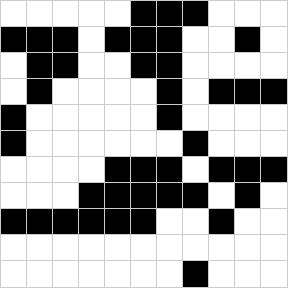

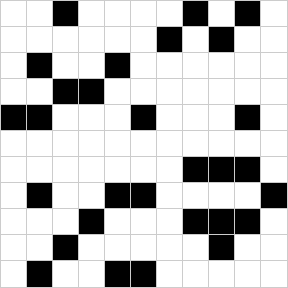
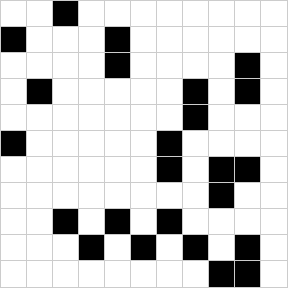
- In every row there exists a black cell. (Statement 1)
- There exists a column such that all its cells are white. (Statement 2)
- There exists a row such that all its cells are white. (Statement 3)
- In every column there exists a black cell. (Statement 4)
- I was not happy with the notes that I wrote in OpenBoard during today's class. So, I rewrote the notes for today's class in GoodNotes.
- I post a pdf file of the notes that I wrote today during the class.
-
For this weekend
- Review three proofs of Proposition 5.1 and make sure that you understand them. Reflect on similarities and differences in the proofs. Notice that the third proof uses the theorem which states that a quadratic equation with a nonnegative discriminant has a solution. I will give a proof of that theorem as the last item today.
- Read the new version of the class notes up to and including Floor and Ceiling functions.
-
Theorem. Let $a,b,c$ and $x$ be real numbers. Assume that
\[
a \neq 0 \quad \text{and} \quad b^2 - 4 a c \geq 0.
\]
Then the following equivalence hold
\[
ax^2 + b x + c = 0 \qquad \Leftrightarrow \qquad x = \frac{-b - \sqrt{b^2 - 4 a c}}{2a} \ \ \text{or} \ \ x = \frac{-b + \sqrt{b^2 - 4 a c}}{2a}.
\]
This theorem is certainly Background Knowledge, but it is an interesting review to have a fresh look at this theorem and try to prove it. Reading Section 1.1 of the notes posted in the next item can help. I started writing this proof and hopefuly I will finish soon.
The Background Knowledge.Proof. Assume $a, b, c, x \in \mathbb{R},$ $a\neq 0$ and $b^2-4ac \geq 0.$ Since $a \neq 0$, by Axiom MR the reciprocal $1/a$ is a real number and by Axiom DL we have \[ ax^2 + b x + c = a \left( x^2 + \frac{b}{a} x + \frac{c}{a} \right). \] Since $a\neq 0$, applying BK 3 to the preceding equality we deduce that \begin{equation} \label{eq:st} \tag{*} ax^2 + b x + c = 0 \quad \Leftrightarrow \quad x^2 + \frac{b}{a} x + \frac{c}{a} = 0. \end{equation} Next we rewrite the quadratic expression $x^2 + \frac{b}{a} x + \frac{c}{a}$ as a product of two linear expressions: \begin{align*} x^2 + \frac{b}{a} x + \frac{c}{a} & \stackrel{\small (i)}{=} x^2 + 2\frac{b}{2a} x + \frac{b^2}{4a^2} - \frac{b^2}{4a^2} + \frac{c}{a} \\ & \stackrel{\small (ii)}{=} \Biggl( x + \frac{b}{2a} \Biggr)^2 - \frac{b^2-4ac}{4a^2} \\ & \stackrel{\small (iii)}{=} \Biggl( x + \frac{b}{2a} \Biggr)^2 - \Biggl( \frac{\sqrt{b^2-4ac}}{2a} \Biggr)^2 \\ & \stackrel{\small (iv)}{=} \left( x + \frac{b}{2a} - \frac{\sqrt{b^2-4ac}}{2a} \right)\left( x + \frac{b}{2a} + \frac{\sqrt{b^2-4ac}}{2a} \right) \\ & \stackrel{\small (v)}{=} \left( x - \frac{-b + \sqrt{b^2-4ac}}{2a} \right)\left( x - \frac{-b - \sqrt{b^2-4ac}}{2a} \right) \end{align*} To summarize, we proved \[ x^2 + \frac{b}{a} x + \frac{c}{a} = \left( x - \frac{-b + \sqrt{b^2-4ac}}{2a} \right)\left( x - \frac{-b - \sqrt{b^2-4ac}}{2a} \right). \] By BK 3 we deduce that \[ x^2 + \frac{b}{a} x + \frac{c}{a} = 0 \quad \Leftrightarrow \quad \left(x - \frac{-b + \sqrt{b^2-4ac}}{2a} = 0 \right) \bigvee \left(x - \frac{-b - \sqrt{b^2-4ac}}{2a} = 0 \right). \] Since clearly \[ x - \frac{-b + \sqrt{b^2-4ac}}{2a} = 0 \quad \Leftrightarrow \quad x = \frac{-b + \sqrt{b^2-4ac}}{2a} \] and \[ x - \frac{-b - \sqrt{b^2-4ac}}{2a} = 0 \quad \Leftrightarrow \quad x = \frac{-b - \sqrt{b^2-4ac}}{2a}, \] we conclude that \[ x^2 + \frac{b}{a} x + \frac{c}{a} = 0 \quad \Leftrightarrow \quad \left(x = \frac{-b + \sqrt{b^2-4ac}}{2a}\right) \bigvee \left(x = \frac{-b - \sqrt{b^2-4ac}}{2a} \right). \] The last equivalence, together with the equivalence $\eqref{eq:st}$ yield \[ a x^2 + b x + c = 0 \quad \Leftrightarrow \quad \left(x = \frac{-b + \sqrt{b^2-4ac}}{2a}\right) \bigvee \left(x = \frac{-b - \sqrt{b^2-4ac}}{2a} \right). \] This proves the theorem.BK 1. For every nonnegative real number $v$ there exists a unique nonnegative real number $u$ such that $u^2 = v$. The number $u$ is called the square root of $v.$ We use the standard notation $u = \sqrt{v}.$ BK 2. Here I will list the Axioms of $\mathbb{R}$ which we use. BK 3. Theorem 1.1(iv) states: For $u,v \in \mathbb{R}$ we have $uv = 0$ if and only if $u=0$ or $v=0.$ - A comment about the above proof: The above proof uses quite a bit of algebra, Theorem 1.1(iv) from the notes and, most importantly, BK 1. I say most importantly since this is the only Background Knowledge that we will be able to prove only towards the end of this class. That is also the only part of this proof which uses on the Completeness Axiom. We will prove BK 1 by using sequences. Another way is to first prove the Intermediate Value Theorem for continuous functions and prove BK 1 as a corollary. I consider this as a drawback of the third proof of Proposition 5.1 in ``A Brief Review....'' The third proof might be the simplest, but uses too heavy of a tool. In general, I think it is a good idea to always look for a proof that uses simplest tools. However, having more proofs is always better.
- I post a pdf file of the notes that I wrote today during the class. Here are the annotated class notes that I used today.
-
As I will be rewriting my class notes this weekend I remember some of my thought about writing. I believe in writing. I believe that improvement is possible. I feel that in my classes I am not encouraging you enough to write more and improve your writing. To promote my belief in writing and improving, inspired by "veni, vidi, vici", I wrote:
I came, I thought, I wrote, I taught, I thought more, I rewrote.
Verba volant, scripta manent.
(Spoken words fly away, written words stay.)
- I post a pdf file of the notes that I wrote today during the class. Where do proofs start? Here. And here is a less annotated version.
- Today we talked about the axiomatic foundation of mathematics. The axioms and the rigorous logical development of the theory are what mathematics is, where all authority in mathematics rests. I have spent a lifetime studying mathematics, and I do not have any authority. What I have is something that is much more valuable; I have humility as I learn more of mathematics' rigor, beauty, depth, and vast reach. And I know that mathematical contributions at any level will be judged based on the rigor, accuracy, consistency of their argument, not by somebody's arbitrary authority. And I am proud to be a member of such a community.
- Thank you, Aeelya, for this beautiful noun: humility. I feel that it such a positive word, a word that inspires creation, invites participation.
- I post a pdf file of the notes that I wrote today during the class. It is finishing the proof of Proposition 5.1.
- I thank Aeelya for helping me to formulate this important statement: I cultivate my interests. The relevance of this statement lies in the fact that the interest as a part of curiosity is an essential ingredient of a fulfilling learning experience. And that is why we all are here.
- I post a pdf file of the notes that I wrote today during the class. It is more Logic Makes Sense! and a proof of Proposition 5.1.
- Maya Angelou wrote: "You can't use up creativity. The more you use, the more you have." And I add: What Maya Angelou says applies to the four pillars of learning mathematics: Curiosity, Creativity, Comprehension, Certainty.
- I post a pdf file of the notes that I wrote today during the class. Logic Makes Sense!
-
The following list I posted on Canvas as to do list related to the document
A Brief Review of Mathematical Logic. The key concepts are as follows:
- The concept of a proposition (or a statement)
- Understand the compound propositions
- the negation
- the conjunction ("and")
- the disjunction ("inclusive or")
- the implication or conditional ("If ..., then ...")
- the equivalence or biconditional ("If ... and only if ...")
- Understand the negations of the above compound propositions
-
For a given implication \( p \Rightarrow q \) understand the concepts of
- the converse: \( q \Rightarrow p \)
- the contrapositive: \( \lnot q \Rightarrow \lnot p \)
- the inverse: \( \lnot p \Rightarrow \lnot q \)
- The concept of a propositional function or a predicate
- The concept of quantified statements with the universal quantifier \( \forall \) and the existential quantifier \( \exists \)
- The negations of quantified statements
- Understand how I use colors in proofs
- Understand the proof of Proposition 5.1
- Please report errors and typos in the document
- Affirming the title of a book by Cassius J. Keyser, I say: There is a human worth in rigorous thinking. And I add: Mathematics is the best setting to practice rigorous thinking. Mathematics provides you with an environment where you can practice rigorous thinking on well-defined tasks at infinitely many different intellectual challenge levels. Even more, with computational technology, you can add an experimental component to your thinking.
- We will start with A Brief Review of Mathematical Logic. I like using colors in proofs. In one proof in the Review I demonstrate how I use colors in proofs.
- The information sheet
- The class notes. (updated April 5, 2020) I will keep updating the notes. The new version will be posted the first Monday.
- Some useful Wikipedia links: